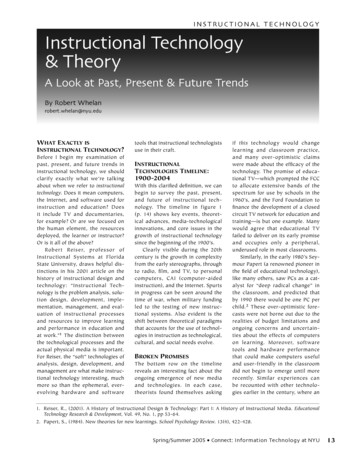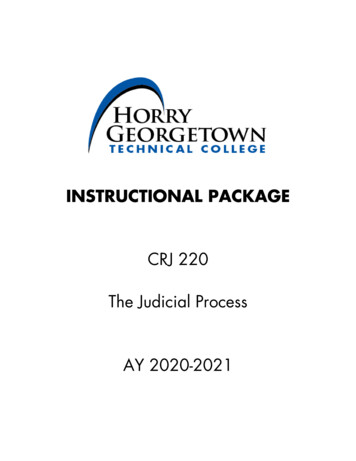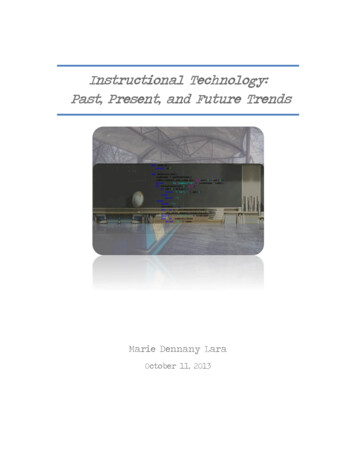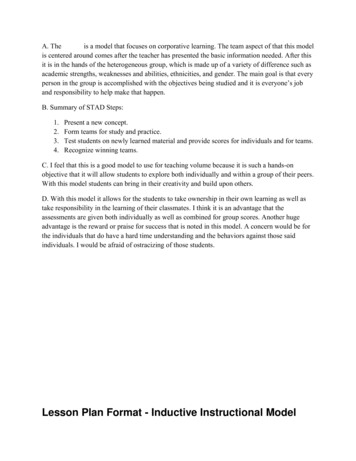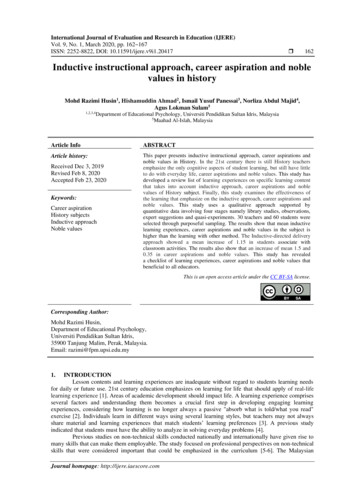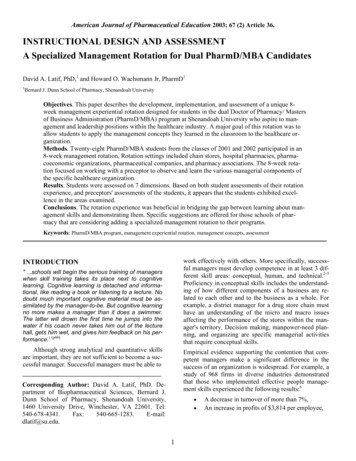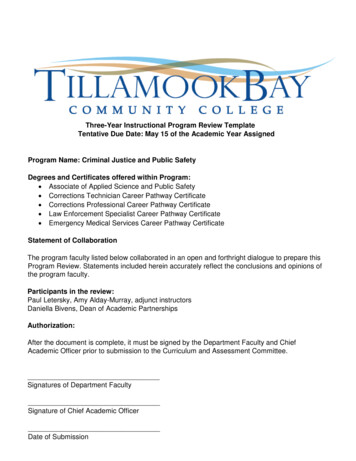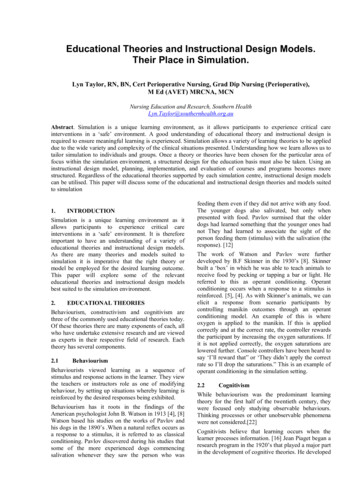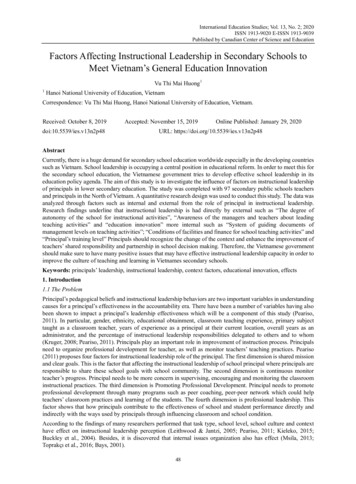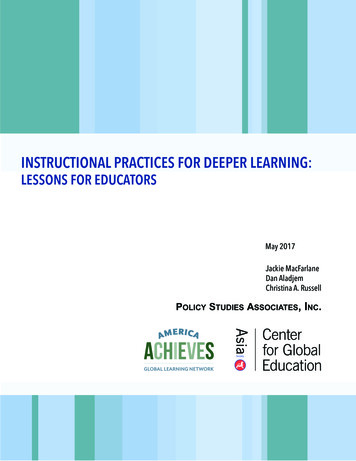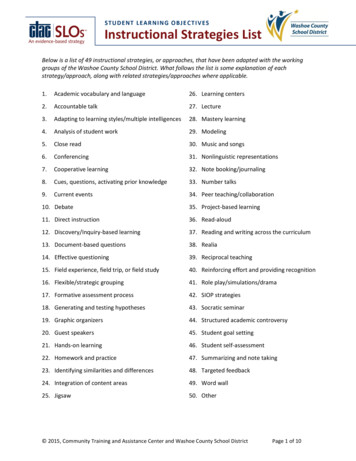
Transcription
Instructional Strategies ListBelow is a list of 49 instructional strategies, or approaches, that have been adapted with the workinggroups of the Washoe County School District. What follows the list is some explanation of eachstrategy/approach, along with related strategies/approaches where applicable.1.Academic vocabulary and language26. Learning centers2.Accountable talk27. Lecture3.Adapting to learning styles/multiple intelligences28. Mastery learning4.Analysis of student work29. Modeling5.Close read30. Music and songs6.Conferencing31. Nonlinguistic representations7.Cooperative learning32. Note booking/journaling8.Cues, questions, activating prior knowledge33. Number talks9.Current events34. Peer teaching/collaboration10. Debate35. Project-based learning11. Direct instruction36. Read-aloud12. Discovery/Inquiry-based learning37. Reading and writing across the curriculum13. Document-based questions38. Realia14. Effective questioning39. Reciprocal teaching15. Field experience, field trip, or field study40. Reinforcing effort and providing recognition16. Flexible/strategic grouping41. Role play/simulations/drama17. Formative assessment process42. SIOP strategies18. Generating and testing hypotheses43. Socratic seminar19. Graphic organizers44. Structured academic controversy20. Guest speakers45. Student goal setting21. Hands-on learning46. Student self-assessment22. Homework and practice47. Summarizing and note taking23. Identifying similarities and differences48. Targeted feedback24. Integration of content areas49. Word wall25. Jigsaw50. Other 2015, Community Training and Assistance Center and Washoe County School DistrictPage 1 of 10
Instructional Strategies List#Instructional Strategy/Approach1Academic vocabulary and languageAcademic vocabulary and language is used in academic dialogue and text and may not necessarilybe encountered in conversation, though it relates to more familiar words that students use, suchas observe rather than watch. Understanding academic vocabulary and language helps studentsto understand oral directions and classroom instructional dialogue and to comprehend textsacross different content areas, including math, science, and social studies/history. Important forall learners, academic vocabulary and language must be taught explicitly, particularly to secondlanguage learners. Generally, vocabulary is categorized into three tiers: (1) Basic vocabulary orwords most children will know, including high-frequency words that usually are not multiplemeaning words. (2) Less familiar, yet useful vocabulary found in written text and shared betweenthe teacher and student in conversation and referred to in the Common Core as “generalacademic words.” Also called “rich vocabulary,” these words are more precise or subtle forms offamiliar words and include descriptive and multiple meaning words. Instead of walk, for example,saunter might be more descriptive. (3) The third tier of words is called “domain specific” in theCommon Core and refers to words that carry specific concepts of the subject matter or processestaught in schools. Generally, they have low frequency use and are limited to specific knowledgedomains (e.g., isotope, peninsula, or mitosis), which are best learned with content lessons and arecommon in informational texts.Accountable talkTalking with others about ideas is fundamental to classroom learning. Classroom talk thatpromotes and sustains learning should be accountable to other learners, use accurate andappropriate knowledge, and adhere to rigor in thinking. Accountable talk responds to and furtherdevelops what others have said through relevant observations, ideas, opinions, or moreinformation. Accountable talk draws on evidence appropriate to the content area (e.g., a proof inmath, data from investigations in science, textual details in literature, primary sources in socialstudies) and follows the rules of reasoning.Adapting to learning styles/multiple intelligencesThe cognitive theory of multiple intelligences posits that students learn, remember, perform, andunderstand in different ways, including various intelligences, such as musical–rhythmic, visual–spatial, verbal–linguistic, logical–mathematical, bodily–kinesthetic, interpersonal, intrapersonal,and naturalistic. As a cognitive theory, learning styles/multiple intelligences is controversial buthas proved useful to classroom teachers in fostering different interests, providing variety anddifferentiation in instruction, and developing the whole child.2345Analysis of student workAnalysis of student work may be (1) a feature of a lesson conducted by a teacher or (2) individualfeedback provided to students from a teacher; (3) a discussion among a small group of studentswho are providing feedback to one another; (4) a discussion among teachers of the aspects ofstudent work; and/or (5) a mode of formally assessing a skill, such as writing. For any of theforegoing purposes, some protocol describing the attributes and levels of quality for theparticular learning task is required as the basis of an analysis. When used in formal assessmentsituations, anonymous student exemplars that illustrate various responses and levels of qualityplus an analysis of inter-rater reliability promote consistency and validity.Close readClose reading refers to approaching a variety of texts of sufficient complexity through amethodical examination (often used in poetry explication) in order to uncover layers of meaning 2015, Community Training and Assistance Center and Washoe County School DistrictRelatedStrategy/Approacha. Close readingb. SIOP strategiesc. Word walla. Cooperativelearningb. Discovery/Inquiry- based learningc. Socratic seminara. Field experience,field trip, or fieldstudyb. Hands-on learningc. Learning centersd. Music and songse. Role play/simulations/dramaa. Conferencingb. Student selfassessmenta. Document-basedquestionsPage 2 of 10
Instructional Strategies List6789101112that lead to deeper comprehension. How a text is written is as important as the content itself inunderstanding the author’s meaning. Deriving meaning from a close reading of a text requiresattention to how the text makes meaning through imagery, word choices, and sentence structureas well as how the central idea, tone, and voice are revealed through the choices of detail andlanguage. Emphases on close reading of complex texts reflect priorities of the Common Core.ConferencingA one-to-one teacher conference with a student about his or her work in progress is prevalent inteaching writing and speaking, but it is also useful in other areas. The purpose of the conference-engaging in meaningful conversation about the student’s work in progress--will not be realizedautomatically. Preparation (on the part of both the teacher and the student) before theconference, careful listening during the conference, recordkeeping, and follow-up are essentialcomponents for a successful outcome. In student-to-student conferencing, participants requireguidance, a focused protocol, and accountability.Cooperative learningStudents in small heterogeneous groups take roles and learn to share knowledge and tasks withone another through a variety of structures with this strategy. While different experts categorizethese differently, common features of effective cooperative learning include team building,positive interdependence, group interaction, structured activity, and individual accountability.Cues, questions, activating prior knowledgeWith respect to Ausabel’s cognitive theory that learning new knowledge and skills relies on whatis already known, teachers use many strategies to help students activate their prior knowledgeand eliminate irrelevant and possibly erroneous knowledge. Cues and questions are among themost frequent ways that teachers prompt students to recall and use what they have alreadylearned. Effective questions and cues focus on what is important and benefit from a judicious useof “wait time” and higher-level questions.Current eventsContent material taken from current news and information can be used as an occasional orregular teaching strategy to add relevance to a lesson topic or content. Benefits include helping todevelop reading/viewing habits, build skills in analysis/critique, and learn presentation skills.Common in social studies, connections to current events help students see relevance in anysubject area.DebateDebate is a structured form of argumentations that requires participants to engage in research,develop listening and oratory skills, and think critically. Debating can be employed as aninstructional strategy wherever the learning material and circumstances are open to opposingpoints of view. Debates may be viewed or read to contribute additional perspectives on aclassroom topic.Direct instructionGeneral usage of the term “direct instruction” refers to instructional approaches that arestructured, sequenced, and led by teachers and/or present academic content through teacherlecture or demonstration. Many components of direct instruction are basic to effective teaching,including identifying learning goals, organizing and sequencing lessons to strengthenunderstanding, modeling a process, providing descriptions and illustrations, checking forunderstanding, and providing feedback.Discovery/Inquiry-based learningInquiry learning is based on constructivist theories of learning, where knowledge is “constructed”from experience and process. It covers a range of approaches, including: field work, case studies,investigations, individual and group projects, and research projects. It is the hallmark strategy of 2015, Community Training and Assistance Center and Washoe County School Districta. Analysis ofstudent workb. Student goalsettingc. Student selfassessmenta. Jigsawb. Structuredacademiccontroversya. Effectivequestioninga. Document-basedquestionsb. Structuredacademiccontroversya. Current eventsb. Discovery/Inquiry-based learninga. Lectureb. Modelinga. Field experience,field trip, or fieldstudyb. Hands-on learningPage 3 of 10
Instructional Strategies List1314151617science, and often social science, learning. Specific learning processes that students engage induring inquiry include: developing questions, seeking evidence to answer questions, explainingevidence, and justifying or laying out an argument for the evidence. Progress and outcomes areassessed through observing students’ learning develop over time through conversations,notebook entries, student questions, procedural skills, use of evidence, and other techniques.Document-based questionsA document-based question (DBQ) is an essay question or series of short-answer questions on anexamination where students are asked to construct a response using one's own knowledgetogether with an analysis of provided documents. The documents provided can be from text butcan also include primary and secondary sources, pictures, political cartoons, maps, graphs, orcharts. Often, the sources are selected to provide different perspectives or views. Documentbased questions were developed for the Advanced Placement History test several decades pastbut since have migrated to other content areas and are explicitly taught in AP classes. DBQ as ageneral teaching and assessment strategy has been highlighted by Common Corerecommendations that students read like detectives and use text in developing their responses.Effective questioningTeacher questioning and student response are common classroom learning activities. Researchfinds that teacher questions (and cues) are effective when they focus on what is important,require students to respond at higher levels, provide adequate wait time after a question is askedand establish an engaging introduction for the lesson. Effective questioning can also play a role infocusing students on unit learning goals or overarching themes throughout a longer period ofstudy.Field experience, field trip, or field studyOften thought of as enrichment or reward activity, experiences outside the classroom enablestudents to extend classroom learning into real world locales, such as when visiting a natural orhistorical site, exploring current trades and industries on-site, or working alongside an expert in afield of study. The experience is maximized for students when the purpose is clear, including howthey will report on their observations, questions, and conclusions. When feasible, research showsthis type of learning to be quite powerful compared to simulations or contrived experiencesmirroring the real-world in the classroom.Flexible/strategic groupingInformally grouping and regrouping students for a variety of purposes throughout the school dayor during an instructional unit supports the learning of all students. Flexible grouping strategiesare used to meet curricular goals, engage students, and respond to individual needs. Flexiblegrouping helps teachers overcome the disadvantages of ability grouping while still attending toindividual performance issues. Both teacher-led and student-led groups will contribute tolearning, but grouping decisions should respond to the dynamics inherent in each type of group.Teacher-led groups are the most common configuration—whole-class, small group, and individualinstruction—and provide an efficient way of introducing material, summing-up conclusions fromindividual groups, meeting the common learning needs of a large or small group, and providingindividual attention or instruction. Student-led groups take many forms, but share a commonfeature—that students control the group dynamics and have a voice in setting the agenda.Student-led groups provide opportunities for divergent thinking and encourage students to takeresponsibility for their own learning.Formative assessment process"Formative assessment is a deliberate process used by teachers and students during instructionthat provides actionable feedback that is used to adjust ongoing teaching and learning strategiesto improve students' self- assessment,
language learners. Generally, vocabulary is categorized into three tiers: (1) Basic vocabulary or words most children will know, including high-frequency words that usually are not multiple meaning words. (2) Less familiar, yet useful vocabulary found in written text and shared between
